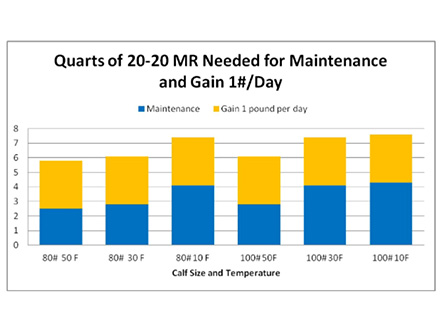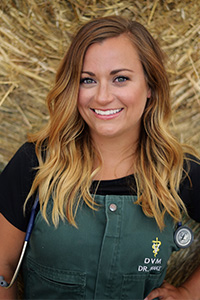By Dr. Marissa Hake, Calf Vet
We’ve historically fed calves to meet their maintenance needs, but not to their full potential. There’s lots of reasons why – milk replacer cost, bucket or bottle size limitations, fear of over-feeding or nutritional “scours”. Or maybe it’s an even worse reason like “This is the way we’ve always done it”. We’re not feeding cows the way we did 30 years ago, so why are we still feeding our calves the same way?
The standard milk replacer feeding program has traditionally been 2 quarts of milk replacer (at 12% solids) fed twice a day. This program was developed to drive calves to eat more grain but leads to poor weight gains in the first month of life. We have fed calves this way to get them off milk and onto solid feed because milk replacer is expensive as compared to grain. One thing that we must remember is in the first 3+ weeks of life, the calf’s rumen is developing, and we cannot rely on grain to provide enough calories for the calf. In addition, calves are only born with 2-4% body fat, so they cannot rely on fat reserves to sustain them in the first month of life either. Restricting calories during the most vulnerable time results in poor growth and increased susceptibility to disease.
We often forget that calfhood diseases impact future lactating performance. So, while it might be a long 2 years until that newborn heifer steps hoof into your parlor, what happens to her in the first couple months of life will pre-determine your return on investment. Research has shown that for each pound of daily gain pre-weaning, milk production increased by 1,540 lbs. in the first lactation or 6,000 lbs. over three lactations. Management and nutritional practices during calfhood have 3-7 times more influence on future milk production than sire selection!
So why is the traditional 2 quarts of milk replacer twice a day not optimal? First, we need to discuss maintenance energy.
What is maintenance energy? Maintenance energy is what the calf needs to just maintain normal body functions, body temperature, and stay alive. This is the energy used before the calf can allocate resources to grow. A calf’s maintenance energy increases as their body size increases. So, the maintenance needs of a 60lb calf are less than that of a 110lb calf, yet we feed them the same way. Maintenance energy also changes based on ambient temperature and thermal conditions. This means a calf in a wet and drafty pen will require more energy than a calf in a dry, well-ventilated pen, even at the same temperature. Maintenance energy also increases with disease pressure. Sick calves require more energy to mount an immune response. In my opinion, what you don’t pay for in milk the first month of life, you’ll pay for in performance, treatments, and death loss.
The chart below from Cornell University shows how many quarts of 20:20 milk replacer that a calf needs based on body weight and ambient temperature. The blue bars show how much MR is needed to meet maintenance energy (just stay alive) and the yellow bars represent the additional MR needed to achieve 1 lb of gain per day. The left side of the chart is the number of quarts/day the calf would need of 20:20 milk replacer. As you can see, when temperatures decrease the calves need to be fed more for maintenance energy. Also, you can see that with the traditional 4 quarts/day feeding program the 80lb calf at 10 degrees and the 100 lb calf at 30 degrees and below are not growing and possibly losing weight. Another thing to note is that at optimal temp of 50 degrees, the 100lb calf requires more for maintenance than the 80 lb calf.

What does this mean? At an optimal temperature of 50 degrees, our 80 and 100 lbs calves will gain very little in the first 3-4 weeks, but will hopefully get to the point where they are eating enough grain to start using that for growth. If the temperature drops to 30 degrees F our 80lb calf is now gaining very little and our 100 lb calf is losing weight! I hear calf raisers say this all the time “I would rather raise the 70-80 lb calves than the big 100lb calves. The smaller ones do better, probably because less stress at birth”. I argue it’s that we’re not optimally feeding those larger calves making them more prone to disease. Again, remember these calves are less than 4 weeks old and rely completely on milk to survive. We need to provide our calves with more calories to grow and thrive.
According to the Dairy Calf and Heifer Association’s Gold Standards for Heifer Growth, it’s recommended that calves should be doubling their birth weights in the first 56 days of life. In order to achieve this, an 80 lb calf would need to be gaining 1.4lbs+ per day. If we consider our chart above, an 80lb calf at IDEAL conditions with 0 disease stress would require almost 6 quarts of 20:20 milk replacer to achieve 1lb of gain per day.
How to provide more calories for growth
- Increase volume
- Increase calories
Increasing volume is relatively easy and most calves can tolerate greater than 4 quarts daily. Smaller calves sometimes can’t tolerate that large of volume so adjustments should be made based on size. If farms can swing the logistics, feeding 3 times a day can also help increase volumes fed. Another option is to increase the caloric content of the milk. This can be done by feeding bulk tank milk or by adding extra milk replacer to your mix. Adding 2-4 extra ounces can increase energy by 25-50. You can also use a higher fat:protein milk replacer or add a balancer to your current milk replacer or bulk tank milk. Make sure that you are closely monitoring the total solids and feeding above 12-13% solids should only be done if calves have access to free-choice water!

One lesson that I’ve learned along the way is “feed calves based on your top 50%, not your bottom 10%”. We need to stop making feeding decisions that hold back our top calves.
Nutrition is just one piece of the calf health puzzle, so make sure to work with your veterinarian and nutritionist to develop your herd health and feeding programs.
Dr. Marissa Hake is a veterinarian who has focused her career on calf management and welfare. In her previous role she managed 60,000+ pre-weaned calves annually and is passionate about developing practical ways to improve calf care. Feel free to contact her at drhakecalfvet.com with any questions.

References
https://www.wvdl.wisc.edu/index.php/calf-maintenance-in-cold-weather/#:~:text=to%204%20quarts.-,Feed%20the%20calves%203%20quarts%20of%20milk%20or%20milk%20replacer,instead%20of%20twice%20a%20day.https://extension.psu.edu/feeding-the-newborn-dairy-calf
http://livestocktrail.illinois.edu/dairynet/paperDisplay.cfm?ContentID=358
https://www.progressivecattle.com/topics/feed-nutrition/brown-fat-ensures-survival-in-calves
https://dairy.osu.edu/newsletter/buckeye-dairy-news/volume-21-issue-1/cold-weather-dairy-calf-care
Amaral-Phillips, D.M. Dairy Calf Management Practices Impact Future Production. University of Kentucky College of Agriculture, Food and Environment.
https://vet-advantage.com/vet_advantage/improved-calf-health-benefits-long-term-performance/
